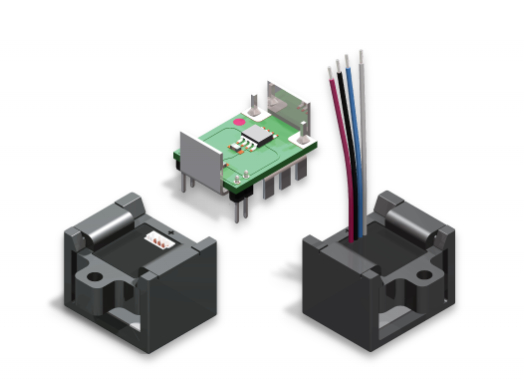What Is A Hall Effect Current Sensor and How It Works
Electrical current measurement and monitoring are now essential parts of many systems and gadgets in today’s technologically advanced society. A current sensor is beneficial in this situation. A few applications for these sensors include:
Industrial machinery,
Automobile electronics,
Power systems, and
Consumer electronics
Because of their accuracy, dependability, and versatility, Hall Effect current sensors have become especially popular among the several types of current sensors that are now on the market.
We’ll look at the definition, operation, and typical applications of a Hall Effect current sensor in this post. We’ll also discuss the differences between several kinds of sensors such as AC, DC, and magnetic current sensors. Furthermore, you can also learn why Hall Effect technology is unique. Let’s move forward!
What is a Hall Effect Current Sensor?
A Hall Effect current sensor is a kind of magnetic current sensor that measures the magnetic field created by an electric current flow by implementing the Hall Effect principle. A magnetic field applied perpendicular to the flow of electric current through a conductor results in a voltage differential across that conductor. All this process is termed as the Hall Effect, which Edwin Hall discovered in 1879.
This voltage is detected by Hall Effect current sensors. This sensor utilizes it to calculate the direction and strength of the current flowing through a wire or circuit. Hall Effect sensors offer non-contact measurement. It significantly improves durability and safety in contrast to conventional shunt-based sensors that need direct electrical contact.

How Does a Hall Effect Current Sensor Work?
A Hall Effect current sensor usually comprise three main components:
Magnetic core: Aims the magnetic field created by current.
Signal conditioning current: Converts the Hall voltage into a readable output.
Hall element: Senses the magnetic field and produces a voltage.
A magnetic field proportionate to the current is produced when current passes through a conductor close to the sensor. This field is detected by the Hall element, which generates a tiny voltage. This voltage is raised and processed by the signal conditioning circuit, which then converts it into a signal that a monitoring system can read.
This procedure makes the current sensor perfect for both AC current senor and DC current sensor applications since it enables precise current measurement without requiring the circuit to be broken.
Types Of Current Sensors
Examining the larger class of existing sensors is useful in order to completely comprehend the role that Hall Effect sensors play. These can be categorized according to the kind of current they measure and how they work.
1. Magnetic Current Sensors
The magnetic field produced by the current flow is used by magnetic current sensors to take measurements. This group includes fluxgate and magneto resistive sensors as well as Hall Effect sensors. In applications where non-contact measurement is crucial, these sensors are quite helpful.
2. AC Current Sensor
Alternating current can be measured with an AC current sensor. These frequently detect changes in current using transformers or inductive coils. Hall Effect current sensors offer greater flexibility because they can detect both AC and DC currents, whereas standard AC sensors are only able to measure sinusoidal waveforms.
3. DC Current Sensor
Particularly employed in solar power systems, electric vehicles, and battery monitoring, a DC current sensor measures direct current. Because Hall Effect sensors can detect static magnetic fields, which indicate steady current flow, they are particularly well-suited for measuring DC current.
Advantages of Hall Effect Current Sensors
There are several reasons why Hall Effect current sensors are widely used across various industries:
1. Non-Invasive Measurement
Hall sensors allow for non-contact current sensing, which means the wire or conductor does not need to be physically altered or interrupted. This is a significant safety and design benefit, especially in high-voltage environments.
2. AC and DC Compatibility
Unlike many sensors that are limited to either AC or DC, Hall Effect current sensors are capable of measuring both, making them highly versatile.
3. Compact and Lightweight
Thanks to their solid-state nature, these sensors are small and easy to integrate into modern electronics, whether it's an industrial automation system or a consumer electronic device.
4. High Accuracy and Linearity
Modern Hall sensors provide precise readings across a wide range of current levels, making them suitable for applications that demand reliability and performance.
5. Durability and Longevity
Since there are no moving parts and minimal wear and tear, Hall sensors have a long operational life and require little maintenance.
Common Applications of Hall Effect Current Sensors
Hall Effect current sensors are found in a wide variety of industries and systems:
Electric Vehicles: To monitor battery current and motor operation.
Solar Energy Systems: For efficient power conversion and storage.
Industrial Automation: To ensure machine safety and operational accuracy.
Consumer Electronics: In devices like smart chargers and power banks.
Power Supply Systems: For load monitoring and fault detection.
These sensors play a vital role in enabling smarter, more energy-efficient technology.
How to Choose the Right Current Sensor
When selecting a current sensor, it’s essential to consider the specific needs of your application:
Current Range: Ensure the sensor can handle the expected minimum and maximum current levels.
Type of Current: Choose between AC current sensors, DC current sensors, or sensors that support both.
Form Factor: Size and mounting style should match your system design.
Accuracy Requirements: Depending on whether you're working with sensitive electronics or industrial-grade machinery.
Output Type: Sensors may output analog voltages, digital signals, or even have integrated interfaces like I2C or SPI.
For projects requiring flexibility, reliability, and long-term performance, Hall Effect current sensors are often the best choice.

Concluding Words:
It is impossible to overestimate the significance of accurate and efficient current measurement in a world where energy efficiency is becoming more and more important. A contemporary, non-invasive way to monitor both AC and DC electrical currents is with a current sensor, such as the Hall Effect current sensor.
Hall Effect current sensors are now the preferred choice for engineers and designers in a variety of industries due to their capacity to function in challenging environments, support a wide range of applications, and provide accurate measurements. The Hall Effect sensor offers unparalleled performance whether you require a DC current sensor for electric vehicles, an AC current sensor for alternating loads, or a magnetic current sensor for a power system.
By understanding how these current sensors operate and their various types, you can make more informed decisions and build more efficient, safe, and future-proof electrical systems.







.png)






